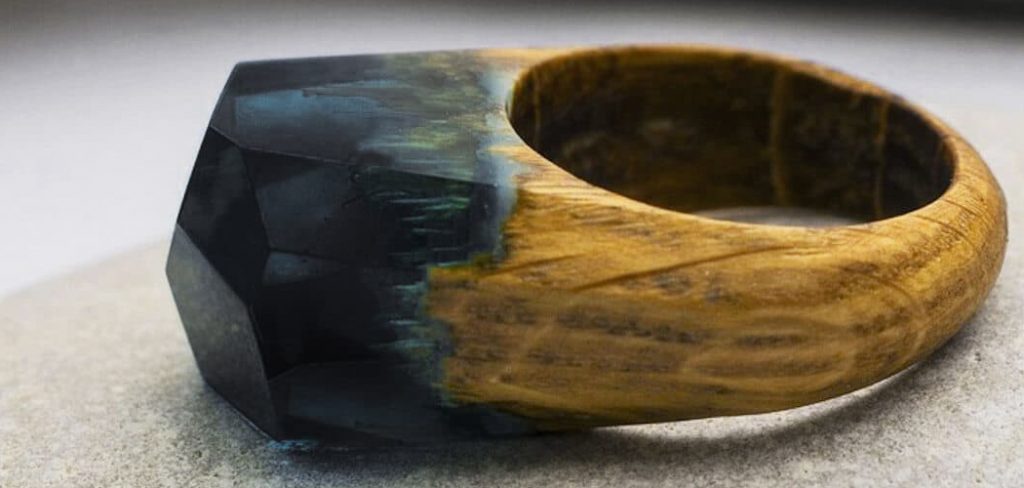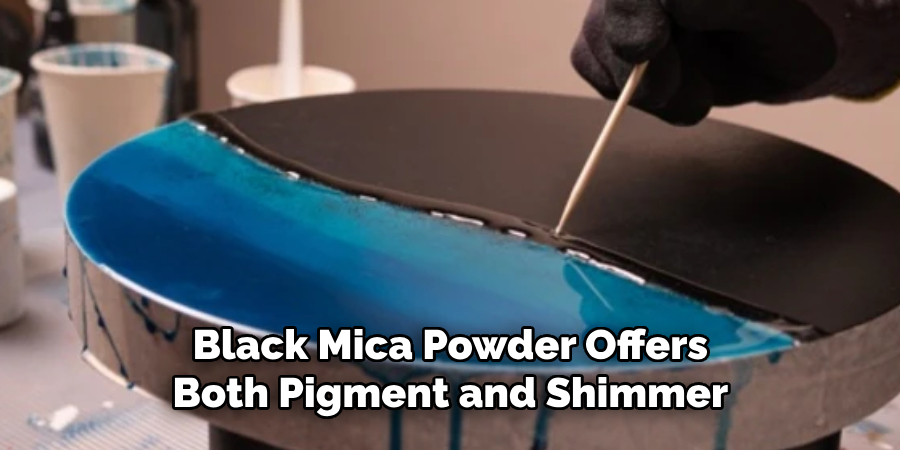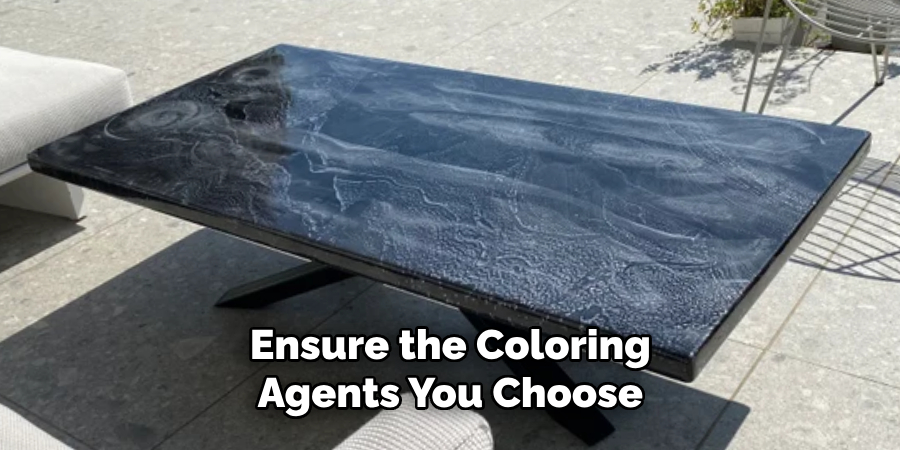Coloring epoxy resin black can open up a world of creative possibilities for crafting, repairs, or artistic projects. Whether you’re creating a sleek, modern finish for tabletops, jewelry, or decorative pieces, achieving a solid black color requires the right techniques and materials. This guide will walk you through the simple steps of how to color epoxy resin black, ensuring a professional and polished look.

Why Choose Black for Epoxy Resin Projects
Black is a timeless and versatile color that brings a sense of elegance and sophistication to epoxy resin projects. Its bold, rich tone complements a wide range of styles, from modern minimalism to classic design. Black epoxy resin can create striking contrast when paired with lighter materials, like wood or metallic accents, making it an ideal choice for artistic and functional designs.
Additionally, black offers excellent opacity, effectively hiding imperfections or uneven textures in the epoxy layer. Whether you’re aiming for a dramatic statement piece or a subtle, polished finish, black epoxy resin provides a professional and refined look that elevates any project.
What You’ll Need
To work with black epoxy resin and achieve stunning results, you’ll need the following materials and tools:
- Epoxy resin (ensure it is high-quality and suitable for your project)
- Black pigment (liquid, powder, or paste, depending on your preference)
- Mixing containers and stirring sticks
- Protective gear (gloves, safety goggles, and a mask to avoid fumes)
- Heat source (such as a heat gun or torch to remove air bubbles)
- Mold or surface for pouring the resin
- Leveling tools (to ensure an even layer of resin)
- Drop cloths or plastic sheets (to protect your workspace)
Gathering these items will prepare you to create beautiful and professional-quality projects with black epoxy resin.
10 Methods How to Color Epoxy Resin Black
1. Use Black Epoxy Pigment Paste for Rich, Opaque Results

One of the most effective and professional methods for coloring epoxy resin black is using a purpose-made black epoxy pigment paste. This dense, concentrated pigment is specifically designed to blend seamlessly with resin, producing a deep, opaque color that cures uniformly.
To use, add a small amount—typically no more than 10% of the total resin volume—into your mixed resin and hardener, and stir thoroughly until the color is completely uniform. This method is ideal for high-gloss pours, such as river tables or jewelry, where an even and intensely dark finish is critical.
2. Mix in Black Alcohol Ink for a Translucent Effect
If you’re looking for a smoky, see-through black rather than a solid, opaque one, black alcohol ink is your best bet. Alcohol ink disperses beautifully in epoxy, creating interesting swirls and gradient effects. It is important to add the ink gradually—a few drops at a time—so you can control the transparency. This method works particularly well in artistic applications such as coasters, abstract art, and layered resin pieces. However, keep in mind that alcohol ink can affect the curing process if overused, so always follow the recommended ratios.
3. Add Black Mica Powder for a Shimmery, Dimensional Finish
For a glamorous, metallic black look, black mica powder offers both pigment and shimmer. Mica is a natural mineral that reflects light and, when mixed into resin, adds depth and sparkle. Simply add a small spoonful of black mica powder to your resin and stir until the mixture becomes silky and lustrous. You can control the intensity by varying the amount of powder. This method is perfect for decorative items like trays, jewelry, and art panels, especially when you want the black to have more character than flat pigment.

4. Use Black Resin Dye for a Strong Yet Flowing Hue
Liquid black resin dyes are formulated specifically for epoxy and are widely available. These dyes create a strong color without affecting the resin’s curing properties. Add a few drops into your resin mix and stir well. Dyes are more fluid and concentrated than acrylics or inks, and they allow for easy color layering or blending. Black dye is perfect when you want a true black that doesn’t compromise clarity in thin pours or intricate molds.
5. Mix in Acrylic Paint Cautiously for Cost-Effective Tinting
Acrylic paint is a popular coloring agent for resin among hobbyists due to its availability and wide range of colors. To color epoxy resin black, you can add a small amount of black acrylic paint—ideally no more than 5% of the resin’s volume. Use a high-quality paint with minimal fillers, and avoid paints that are too watery, as this can interfere with resin curing. While not as potent as specialty pigments, this method works well for quick projects and small-scale crafts like pendants or keychains.
6. Try India Ink for Intense Black Without Clumping
India ink is another viable option for black coloring, particularly when aiming for a dark but fluid finish. Known for its intense pigmentation and smooth consistency, India ink disperses well in resin. Use it sparingly—just a drop or two can go a long way. This ink is especially suited for resin art techniques like ink drops or feathering, where the black spreads organically through clear resin. While it doesn’t offer opacity like pigment paste, it adds artistic versatility.
7. Incorporate Black Eye Shadow or Cosmetic Pigment Powder
Surprisingly, black powdered makeup—like matte eyeshadow or cosmetic mica—can be used to tint epoxy resin. Scrape a small amount into a fine powder and mix thoroughly into your resin until fully blended. These pigments tend to be finer and smoother, resulting in a soft black with a potential matte or satin finish. This method is more experimental but works well for artistic or experimental pieces, particularly if you’re repurposing unused makeup for eco-conscious crafting.

8. Combine Activated Charcoal for a Natural Matte Black
For an organic approach, activated charcoal is an unconventional yet effective pigment. Because it’s ultra-fine and highly pigmented, just a tiny amount can tint your resin a rich black. The result is typically a matte or satin finish, and this method is ideal for those seeking a chemical-free, non-toxic coloring option. Use care during mixing, as the powder is very light and can easily become airborne. This method works best for decorative items that don’t require a glossy finish.
9. Use Toner Powder (Printer Cartridge) for an Industrial Tint
Printer toner powder, particularly from empty cartridges, can also be used as a black pigment in epoxy. This ultra-fine powder disperses smoothly and gives a dark, industrial-looking black. Handle it cautiously—it’s very fine and can be messy. Add small amounts at a time while mixing to ensure even dispersion. This method is not as common but can be a clever upcycling solution if you have access to spent cartridges and are working on non-food-safe items like industrial art or workshop tools.
10. Combine Methods for Custom Black Effects
To achieve a unique black hue with more visual interest, you can combine multiple coloring agents. For instance, mixing black mica powder with a drop of black dye and a hint of alcohol ink can give a layered, dimensional black with shimmer and fluidity. Similarly, pairing black acrylic paint with mica powder can give you a satin-finished black with added texture. Combining coloring techniques allows for greater creative control, letting you craft custom looks tailored to your project—whether it’s a bold tabletop or a detailed mold.
Things to Consider When Working with Coloring Agents

- Compatibility – Ensure the coloring agents you choose are compatible with the base material you’re working with. For example, alcohol inks work well with resin, while acrylic paints are ideal for canvas or wood surfaces.
- Proportions – Using too much coloring agent can affect the consistency or curing process of your medium. Start with small amounts and gradually add more to achieve your desired intensity.
- Mixing Technique – Properly blend your colors to avoid streaks or clumps that can affect the final appearance. Stir thoroughly but gently to maintain the integrity of the medium.
- Longevity and Stability – Consider heat, UV exposure, and wear over time. Some pigments may fade or react under certain conditions, so it’s essential to select durable options for long-lasting results.
- Testing – Always test your chosen combination on a small sample before applying it to your entire project. This ensures the color, texture, and finish meet your expectations.
Conclusion
Coloring black epoxy floor can be achieved in many creative and effective ways depending on the desired finish—whether opaque, translucent, matte, or shimmering. From professional pigment pastes and resin dyes to everyday items like acrylic paint or even activated charcoal, each method brings its own character and application style.
The key to success lies in testing ratios, mixing thoroughly, and always considering the interaction between pigment and resin curing. Thanks for reading our blog post on how to color epoxy resin black! We hope you found it helpful and informative.
About the Author
Adrian Green, a lifelong woodworking enthusiast, shares his passion for the craft through The Woodenify Blog. With a foundation built on years of hands-on experience in his father’s woodworking shop, Adrian is dedicated to helping others learn and grow in the world of DIY woodworking. His approach to woodworking combines creativity, practicality, and a deep appreciation for the art of building with your own hands. Through his blog, he inspires individuals of all skill levels to embark on their own woodworking journeys, creating beautiful, functional pieces of furniture and décor.
Professional Focus
- Specializes in DIY woodworking projects, from furniture to home décor.
- Provides step-by-step guides and practical tutorials for woodworkers of all skill levels.
- Dedicated to helping readers build confidence and skill through easy-to-follow instructions and tips.
- Passionate about fostering a community of makers who can share, learn, and grow together.
Education History
- University of Craft and Design – Bachelor of Fine Arts (BFA) in Woodworking and Furniture Design
- Woodworking Apprenticeships – Extensive hands-on training with skilled craftsmen to refine carpentry and furniture making techniques.
- Online Courses & Masterclasses – Continued education in advanced woodworking techniques, design principles, and specialized tools
Expertise:
- DIY woodworking, carpentry, furniture making, and home décor projects.
- Creating accessible tutorials and guides for beginner to advanced woodworkers.
- Sharing the joys and satisfaction of woodworking, from raw materials to finished products.
